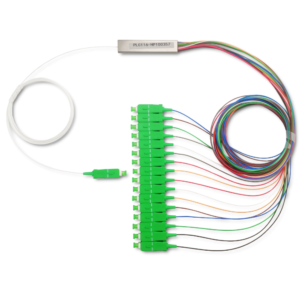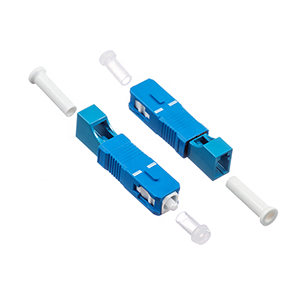50-micron optical fiber plays an important role in communication networks. This article will focus on the characteristics of 50-micron colored optical fiber cables. We will first define the structural composition and working principle of optical fiber cables, and explain the application scenarios of different optical fiber specifications in communication applications.
Next, we will analyze the advantages of 50-micron colored optical fiber cables in terms of fiber size, colored optical fiber, mechanical strength, and optical performance. We will explain the characteristics of 50-micron optical fiber compared to standard 62.5-micron optical fiber in terms of network capacity and transmission distance, introduce the role of colored optical fiber in cable identification and management, and explain its performance in reliability and high-speed transmission.
We will analyze the application of 50-micron colored optical fiber cables in data centers, 5G, FTTH and other fields, and explain its unique advantages in different scenarios. Finally, we will provide the key factors and precautions for selecting 50-micron colored optical fiber cables, and introduce the precautions in actual deployment.
Basic concepts of optical fiber cables
Let me summarize the basic concepts of optical fiber cables for you.
Structural composition and working principle of optical fiber cable:
Optical fiber cable consists of the following main parts:
(1) Optical fiber core: responsible for the transmission of optical signals, achieving low-loss transmission through the principle of total reflection.
(2) Optical fiber cladding: wrapped around the outside of the optical fiber core, plays a role in limiting the leakage of optical signals.
(3) Buffer layer: located outside the cladding, providing a soft protective layer.
(4) Sheath layer: the outer layer is made of plastic or metal, providing mechanical strength and environmental protection.
Through the design of these structural levels, optical fiber cables can effectively transmit optical signals and protect optical fibers from damage by external factors.
Application scenarios of different fiber specifications in communication applications:
(1) Single-mode fiber
- Has a small fiber core diameter, suitable for long-distance high-speed transmission
- Commonly used in trunk networks, long-distance metropolitan area networks, cross-border communications and other scenarios
(2) Multimode fiber
- Has a large fiber core diameter, a shorter transmission distance but a larger bandwidth
- Suitable for short-distance LAN applications such as buildings and campuses
(3) Multi-core fiber
- Contains multiple fiber cores such as 2, 4, 8, 12, etc.
- Suitable for scenarios requiring high-capacity transmission, such as data centers
(4) Special optical fiber
- Such as bend-optimized optical fiber, radiation-resistant optical fiber, etc.
- Used in special environments or application requirements, such as industry, military, etc.
In general, different types of optical fiber cables have their own characteristics in terms of physical structure, transmission performance, etc., and need to be selected based on the needs of actual application scenarios.
Features of 50-micron colored fiber cable
Let me introduce you to the main features of 50-micron colored fiber cable in detail:
Fiber size:
- 50-micron fiber core diameter is smaller than the standard 62.5-micron
- This allows 50-micron fiber to provide a higher number of light-guiding modes and bandwidth
- It also means better bending performance and smaller bending loss
- Therefore, 50-micron fiber has certain advantages in network capacity and transmission distance
Colored fiber:
- 50-micron colored fiber has a protective layer of different colors on the surface of the fiber
- These color codes help to quickly identify and distinguish during cable installation and maintenance
- It can improve electrical Convenience of cable management, reducing the risk of manual errors
Mechanical strength:
- 50 micron colored optical fiber has excellent performance in tensile strength, bending resistance, etc.
- This ensures that the optical fiber cable can still maintain good reliability in harsh environments
- Prolongs the service life of the cable and improves the security of the network system
Optical performance:
- 50 micron colored optical fiber has low insertion loss and bending loss
- This is conducive to achieving high-quality optical signal transmission and meeting the needs of high-speed optical networks
- It also reduces the requirements for optical receiving equipment
In general, 50 micron colored optical fiber has excellent application value in high-speed optical transmission networks with its excellent size, recognition, mechanical strength and optical performance indicators.
Application scenarios of 50-micron colored fiber optic cables
Let me summarize the advantages of 50-micron colored fiber optic cables in major application scenarios:
Data center:
- Data centers have a strong demand for high-density, high-bandwidth optical transmission
- 50-micron optical fiber can provide higher network capacity and transmission speed
- At the same time, its small size and excellent bending performance also simplify the wiring of the computer room
5G network:
- 5G base stations have strict requirements for high-speed, low-latency optical transmission
- 50-micron optical fiber can meet the large-capacity transmission requirements of 5G networks
- Its excellent mechanical strength also meets the deployment requirements of harsh outdoor environments
FTTH access network:
- FTTH network needs to provide stable optical transmission from the central office to the user end
- 50 micron colored fiber can provide sufficient capacity in the trunk and branch segments
- Color coding helps to improve the convenience of cable installation and management
Enterprise/campus network:
- Enterprises and campuses have high requirements for network bandwidth and reliability
- The high capacity and anti-interference performance of 50 micron colored fiber can meet these needs
- At the same time, its simple identification and installation characteristics also simplify network deployment
In short, the excellent performance of 50 micron colored fiber cable makes it widely used in high-speed and high-density optical communication scenarios such as data centers, 5G, and FTTH. It can effectively meet the stringent requirements of these fields for high bandwidth and high reliability.
Selection and deployment of 50 micron colored fiber optic cables
Let me summarize the key factors and considerations to consider when selecting and deploying 50 micron colored fiber optic cables.
Things to note when selecting 50-micron colored fiber optic cable:
(1) Fiber type
- Determine whether single-mode or multimode 50-micron fiber is required
- Ensure compatibility with the optical interfaces of other network devices
(2) Optical performance
- Focus on key indicators such as insertion loss and bending loss
- Ensure that the system’s requirements for high-speed transmission quality can be met
(3) Mechanical properties
- Pay attention to performance parameters such as cable flexibility and tensile strength
- Ensure that it can adapt to the mechanical stress of the installation environment
(4) Color coding
- Choose an appropriate color coding scheme to facilitate cable management
- Ensure consistency with the color standards of existing systems
Deployment considerations for 50 micron colored fiber optic cables:
(1) Path selection
- Try to choose a flat, unobstructed cable laying path
- Avoid excessive bending or mechanical stress on the cable
(2) Connection method
- Ensure that the fiber optic connector is properly docked and fixed
- Check whether the connection is intact
(3) Fixing method
- Use appropriate fixing methods, such as clamps, cable ties, etc.
- Ensure that the cable is not subjected to excessive mechanical stress
(4) Label management
- Keep good color coding and labeling records of cables
- Mark key information such as path, length, connection, etc.
(5) Protection measures
- Take necessary protection measures, such as pipe corridors and pipelines
- Prevent cables from external damage and environmental damage
In short, when selecting and deploying 50-micron colored fiber cables, it is necessary to fully consider their optical performance, mechanical characteristics, color coding and other factors, and take appropriate installation and protection measures to ensure that they can perform at their best in actual applications.
Summary
50-micron colored fiber optic cables play a key role in building high-capacity, high-reliability optical networks. Our company has long focused on the research and development and production of optical communication equipment and its supporting products, and has rich industry experience. The 50-micron colored fiber optic cable products we provide have reached the industry-leading level in terms of fiber size, mechanical strength, optical performance, etc., and can meet your demanding needs for high-speed and efficient network construction.
Whether you need to deploy 50-micron colored fiber optic cables in data centers, 5G networks, or FTTH, we can provide you with customized solutions. At the same time, our professional team will provide you with a full range of technical support, including on-site surveys, solution design, and equipment installation and maintenance. Contact us now to learn more about the application of 50-micron colored fiber optic cables.
50 Micron Colored Fiber Cables FAQ
50 micron fiber optic cables utilize multimode optical fibers with a core diameter of 50 microns.
50 micron multimode fiber has a larger core diameter compared to standard 62.5 micron multimode, enabling higher bandwidth and shorter reach capabilities.
Colored 50 micron fibers help with cable management and fiber identification in high-density applications like data centers.
Typical colors used include aqua, orange, yellow, green, blue, purple, brown, and white.
They are widely used in high-speed Ethernet, Fibre Channel, and other LAN/WAN data center and enterprise networking applications.
Benefits include higher bandwidth, easier cable organization, and faster fault isolation compared to 62.5 micron fibers.
The shorter reach compared to singlemode fiber may limit their use in long-haul or campus backbone applications.
Common fiber counts range from 2 fibers up to 24 or more, depending on the specific application requirements.
Proper cleaning, inspection, and the use of color-matched connectors are critical for reliable performance.
Careful handling to avoid fiber damage, avoiding tight bends, and following the manufacturer’s guidelines are important.



